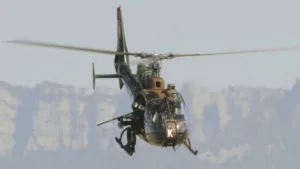Thales took part in a new type of live training exercise from 24 November to 5 December last year as part of the operational training programme for French Army Light Aviation (ALAT) helicopter pilots and air crews. With close to 30 helicopters taking part — some of them real, some of them simulated — the Aozou exercise demonstrated the operational benefits of connecting different simulation systems together in a network.
Two major Thales innovations were crucial to this success.
For the first time ever, two French Army simulation centres physically located more than 150 km apart were connected together to operate as a network, with a total of 12 simulated helicopters interacting in the same tactical scenario. The simulation centres involved were at Phalsbourg (1st Combat Helicopter Regiment) and Etain (3rd Combat Helicopter Regiment) in Eastern France. Both simulation centres are equipped with the Helicopter Mission Trainer (HMT, also known as EDITH for the French Army), a multi-platform tactical training system developed by Thales with the French defence procurement agency (DGA).
The second milestone was the integration of the EDITH simulators with the operational information system so they could share the same tactical situation. Simulated helicopters were presented to commanders and other actors in the exercise in the same way as actual helicopters.
The Aozou exercise showed how Thales technologies interconnect the real world and the virtual world to overcome hardware constraints and reduce the cost of live training by deploying fewer actual helicopters. For the armed forces, these integrated solutions bring a new dimension to operational training in terms of theatre location, the number of actors that take part and the types of scenarios that can be used.
Analyst Comment
To learn more, we sent an email to Thales’ with a few questions. The spokeswoman’s response is below:
How does Thales connect these two simulation centers to share data (dark fiber?)
To connect the two simulation centers , Thales has used a wide area network (WAN) connection and also the High-level architecture (HLA) standard for distributed computer simulation systems.
Was all the tactical information visible on all simulated and live platforms?
Tactical orders from the Regimental Information System (SIR) were visible on the Information Systems Terminal (SITALAT) of the real helicopter as well as on the SITALAT of the simulated platforms.
By cons, the information of the real helicopter were not visible in real time for the pilots in the simulators or vice versa. This represent a next step (to connect the SITALAT of both the live platforms and the simulated ones in real time) that could be achieved on the occasion of a future development in the next stage of the exercise.
How do you protect this data going to the live platforms to prevent hacking into the simulation to alter data?
The broadband line used to connect the SITALAT to the Regimental Information System was secured to either side, allowing secure information uplink and downlink.
Is there more detail on this exercise?
The exercise lasted for a week with different operation training, from November 24 to December 5th, 2014.
It took place on a large area of 200km x 200km in the eastern region of France. Different entities of the French Army Light Aviation (ALAT) were involved, such as the 1st, 2nd and 5th Combat Helicopter Regiment, as well as the Command of Army Light Aviation, ground staff and support Regiment.
In all, 30 real helicopters participated in the exercise, plus 12 HMT simulators over two regiments.

